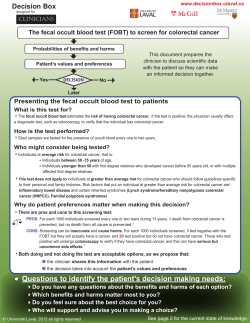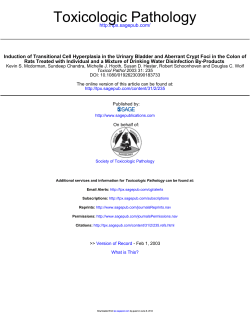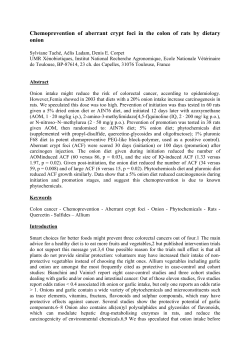
Effect of Apigenin on Bacterial Enzymes and Aberrant Crypt Foci... 1,2-Dimethylhydrazine Induced Colorectal Cancer in Wistar Rats
Global Journal of Pharmacology 6 (2): 81-85, 2012 ISSN 1992-0075 © IDOSI Publications, 2012 Effect of Apigenin on Bacterial Enzymes and Aberrant Crypt Foci in 1,2-Dimethylhydrazine Induced Colorectal Cancer in Wistar Rats 1 Muniyappa Surendra Kumar, 1Vanitha Samuel, 2Natesan Chidambaram, 1 Balamurugan Krishnan and 1Parthasarathy Nirmala Division of Pharmacology, Rajah Muthiah Medical College, Annamalai Nagar, Chidhambaram-608002, Tamilnadu, India 2 Department of Pharmacy, Annamalai University, India 1 Abstract: Colorectal cancer (CRC) is the fourth most common type of cancer and the second cause of death by cancer in the Western world. Epidemiologic studies suggest that increased consumption of fruits, vegetables and high total dietary fiber which contains flavonoids reduces the risk of development of colon cancer. Hence the effect of Apigenin a flavone which is abundant plant derivatives was evaluated in 1, 2-Dimethylhydrazine (DMH) induced colorectal cancer in Wistar rats. The experimental study was carried out in 5 groups, comprising of 6 rats in each group and at 2 dose ranges of 25mg/kg and 100mg/kg. DMH was used to induce CRC in rats and Irinotecan was used as the reference standard. Estimation of bacterial enzymes -glucuronidase and mucinase in both colonic mucosa and fecal matter, Aberrant crypt foci (ACF) showed a significant reduction in the apigenin 100mg/kg group and Irinotecan treated group, when compared to low dose of Apigenin 25mg/kg. In conclusion, our findings indicate that the probable chemopreventive effects of Apigenin in colorectal cancer. Key words: 1,2-Dimethylhydrazine Prevention Apigenin Anti Oxidants INTRODUCTION Colonic Aberrant Crypt Foci Colorectal Cancer (adenomatous polyps) to malignant cancers (carcinomas) [4]. The occurrence of colorectal cancer is strongly correlated with nutritional factors [5, 6]and therefore dietary recommendations have been established to encourage people to change their habits in order to reduce the risk of colon cancer, the burden of personal suffering and the costs of treatment [7]. However, the exact nature and extent of the relationship of colorectal cancer with specific nutrients is not understood [8]. Flavonoids are polyphenolic compounds found as integral components in the human diet. They are universally present as constituents of flowering plants, particularly food plants. Several of polyphenolic compounds regulate the genes that are critical for the control of proliferation, cell cycle and apoptosis pathway in cancer cells. Apigenin, a plant flavonoid with good pharmacological profile and multiple mechanisms of action, suggestive of apoptotic effect towards cancer prevention with least adverse effects has been notified [9]. Hence the present study is to evaluate the effect of Apigenin on bacterial enzymes -glucuronidase and Colorectal cancer is the most common cause of cancer related death in both men and woman in industrialized countries. Most colorectal cancers are sporadic, but a significant proportion (5-6%) has a clear genetic background [1]. The lifetime risk of colorectal cancer in the US population is 5-6%. Over 50% of the population develops adenomatous polyp by the age of 70 years, but only one tenth of these proceed to cancer. Over the past 15 years, evidence in many laboratories has demonstrated that colorectal cancer is a progressive, multistep genetic disease. However, epidemiologic studies have suggested that environmental factors also support the development of colon cancer [2]. About 25% of colon cancer patients have some degree of familial background, yet another 15% have a strong family history involving a first or second degree relative [3]. Colorectal cancer progresses through a series of clinical and histopathological stages ranging from single crypt lesions through small benign tumors Corresponding Author: Muniyappa Surendra Kumar; Division of Pharmacology, Rajah Muthiah Medical College, Annamalai Nagar, Chidhambaram-608002, Tamilnadu, India. Tel: +9600995035. 81 Global J. Pharmacol., 6 (2): 81-85, 2012 mucinase in both colonic mucosa and fecal matter, Aberrant crypt foci (ACF) and to compare its efficacy with Vincristine a well known anticancer agent used in the treatment of colonic cancer. centrifuged 2000r for 5 min and supernatant were used immediately for enzymatic assay. Assay of glucuronidase -glucuronidase activity was measured by method of freeman [10]. This method is based on the spectrophotometric determination of P-nitrophenol liberated from the substrate P-nitrophenyl -Dglucopyranoside in alkaline solution by the action of -glucuronidase. The colour of developed was measured at 540nm [11]. MATERIALS AND METHODS Chemicals and Carcinogen: Apigenin was purchased from RULAND Chemistry Hong Kong; 1,2-Dimethyl hydrazine was purchased from Sigma chemical company St. Louis, USA; Irinotecan was purchased from Dr Reddy’s laboratory, India.; Other reagents and enzymatic kits were of analytical grade and obtained locally. Assay of Mucinase: Mucinase was measured by the method of shai and chang. The amount of reducing sugar (glucose) released from mucin by the action of mucinase enzyme was measured spectrometrically at 520nm [12]. Animals and Experimental Design: All the rats were maintained in an air conditioned room with a 12h light and dark cycle. The animals were provided with vitamin enriched pellet diet consisting of 23% Wheat flour, 60% roasted Bengal gram powder, 5% skimmed milk powder, 4% casein, 4% refined oil, salt mixture with 4% starch and choline. The experimental study was carried out in 5 groups, comprising of 6 rats in each group. Group 1 served as control, received normal pellet diet and water. Apigenin powder (0.1% w/v) was suspended in CMC was given to group 4 animals at a dose of 25mg/kg orally; and to group 5 animals at a dose of 100mg/kg orally, daily for 16 weeks. Group 3 animals received Irinotecan 25mg/kg i.v once a week for four weeks as a standard drug. To all groups (Groups 2, 3, 4 and 5) 1, 2-dimethylhydrazine 20mg/kg body wt s.c once a week for four weeks were given as a carcinogenic agent. The study was started after getting approval from the Institutional Animal ethical Committee. The rats were housed in the animal house, Rajah Muthiah Medical College, Annamalai University. The rats were maintained in accordance with the Indian National Law on animal care and use (Reg. No 190/2007/CPCSEA).The total period of study was 16 weeks. The weights of the rats were recorded at the beginning of the experiment at weekly intervals and at the end of the study period. The animals were sacrificed after overnight fasting at the end of 16 weeks. Quantification of ACF: The colon was processed for the determination of aberrant crypt foci (ACF) by the method described by Bird [13]. The entire colon (from caecum to anus) was removed, washed thoroughly with 0.9% NaCl, opened longitudinally, laid flat on a polystyrene board and fixed with 10% buffered formaldehyde solution overnight. The colon was divided into three equal portions namely the proximal, middle and distal colon and was then stained with 0.2% methylene blue for 3-5 min. in saline in order to identify ACF, a preneoplastic lesion formed by one or more aberrant crypts. ACF are easily visualized on the background of normal crypts since aberrant crypts have larger, often elongated openings and thicker lining of epithelial cells as compared to normal crypts. The total number of ACF/rat was calculated from the sum of all ACF. To determine crypt multiplicity, the number of aberrant crypts in each focus was recorded [14]. RESULTS AND DISCUSSION The drug Apigenin was well tolerated by the animals. Mortality was observed in 1,2-Dimethylhydrazine treated group but not in the drug treated groups. Marginal gain in the weight of animals was observed in the Apigenin 100mg / kg treated group. Colonic tumors was 100% evident in 1,2-dimethylhydrazine treated group(group 2), whereas group 3 and 5 showed reduction in the tumor incidence. Low dose Apigenin did not produce a significant change. Table 1 represents the activity of bacterial enzymes of the various groups. -glucuronidase and mucinase activity estimated was significantly (p<0.05) increased in 1,2-dimethylhydrazine treated rats compared to drug treated groups and normal control values. Supplementation of Apigenin at dose of 100mg / kg showed a significant (P<0.01) lowering of the enzymes in Assesment of Bacterial Enzyme Activity: The colon was separated from small intestine and flushed gently with saline, opened longitudinally and placed on even surface. Samples of mucosa were collected by scraping carefully on the colonic mucosal layer using microscopic slides and fecal samples were also collected and stored. The collected samples were transferred into pre weighed tubes containing 0.1 M phosphate-buffered saline (pH 7.0) and sonicated for 30s. Fecal and mucosal samples were 82 Global J. Pharmacol., 6 (2): 81-85, 2012 Table 1: Effect of apigenin and DMH on colonic mucosal and fecal -glucuronidase and mucinase of control and experimental rats Groups Control DMH DMH+Irinotecan DMH+Apigenin (25mg) DMH+Apigenin (100mg) Colonic mucosa -lucuronidase¶ Mucinase 5.72±0.55a 8.37±0.81b 5.86±0.56a 7.08±0.68 c 5.43±0.52a,d 2.28±0.22 4.05±0.39 2.84±0.27 3.19±0.31 2.50±0.24a,d a b a c Fecal -lucuronidase¶ Mucinase ¶ 19.48±1.88a 23.54±2.27b 19.40±1.87a 21.57±2.08 c 19.60±1.89 a 9.91±0.95a 13.78±1.33b 10.18±0.98a 11.12±1.07 c 9.93±0.96 a µg of p-nitrophenol liberated/h/g protein; mg of glucose liberated /min/mg protein. Data are presented as the means ± SD of six rats. (a-e)P < 0.05 the values not sharing a common superscript letter are significantly different. Fig. 1: Fig. 2: Fig. 3: Fig. 4: Fig. 5: Group 1 (Normal control) Topographical view of normal crypt. Group 2 (Cancer control) Topographical view of ACF showing multiple crypts. Group 3(Irinotecan group) Topographical view of ACF showing 6 crypts in whole mount. Group 4 (Apigenin 25mg/kg body wt.) Topographical view of ACF showing 9 crypts in whole mount. Group 5 (Test drug-Apigenin 100mg/kg body wt.) Topographical view of ACF showing single crypt in whole mount. 83 Global J. Pharmacol., 6 (2): 81-85, 2012 Table 2: Effect of apigenin and DMH on ACF No. of foci containing Groups Total No. of ACF ------------------------------------------------------------------------------------ % Inhibition 1 crypt of ACF 2 crypts > 4crypts Normal control (n=6) --- --- --- --- --- DMH (n=6) 118.1±11.0a 43.4±4.4a 32.8±3.1a 42.9±4.6a --- DMH+Irinotecan (n=6) 36.7±2.8b 21.3±2.1b 15.4±1.4b --- 68.9 DMH+Apigenin (25mg) (n=6) 49.4±4.4c 23.1±2.1b 16.2±1.5b 10.1±0.1b 58.2 DMH+ Apigenin (100mg) (n=6) 30.2±3.0d 16.7±1.5c 13.5±1.2c --- 74.4 Data are presented as the means±SD of six rats. (a-d) p< 0.001 the values not sharing a common superscript letter are significantly different. both colonic mucosa and fecal matter. Chemopreventive agents alter the intestinal micro floral and enzymes change the course of the malignancy. Since the dose of carcinogen, mode of administration and latent period are the determining factors in experimental carcinogenesis, the dose of carcinogen chosen for this study was 20mg/kg given s.c 1,2 DMH once a week for 4 weeks [15]. The reference standard was irinotecan 25mg/kg i.v administered once a week for 4 weeks [16]. The animals were left untreated for the remaining 2 weeks which was considered as latent period. As the solubility of Apigenin was less in water, buffered normal saline was used as vehicle. Apigenin a naturally occurring plant flavone, present abundantly in fruits and vegetables has shown to possess remarkable anti inflammatory, anti oxidant and antiproliferative properties in vitro and In vivo studies are limited [17]. From the results obtained in this study Apigenin at 2 dose levels of 25mg/kg and 100mg/kg elicited varying effects as evidenced by the microbial enzyme analysis. Bacterial -glucuronidase is responsible for the hydrolysis of glucuronidase conjugates in the gut and are important in regeneration of toxic carcinogenic substances[18]. 1,2-DMH by itself is not mutagenic, but in the lumen is activated to azoxy methane and methyl azoxy methane by dehydrogenase reactions. These are then secreted through the bile, back into the intestines. Bacterial flora converts these compounds to aglycones. Thus, 1,2-DMH induces colonic tumours and increases the activity of both colonic and fecal -glucuronidase [19]. Our results comply with this increase in tumour incidence with 1,2-DMH. Treatment with Apigenin at doses of 100mg/kg has significantly decreased the glucuronidase activity, but doses of 25mg/kg however did not show marked changes. Mucinase, an enzyme present in the intestinal microflora hydrolyses the protective mucins in the colon. Mucins coat the intestinal mucosa and function as a lubricants [20]. Amplified degradation of mucin results in 84 direct exposure of colonic cells to toxic carcinogens, which become cancerous. Also, decreased mucinase activity correlates well with a lower incidence of colonic tumours. Thus the findings of the current study is suggestive of the protective effect of Apigenin 100mg / kg / day in reducing the incidence of colonic tumours by suppressing the gut microbial enzymes. Aberrant crypt foci (ACF) are considered to be putative preneoplastic colon lesions that may be early indicators of colon carcinogenesis Aberrant crypt foci developed in rats treated with DMH (group 2) at the end of the experimental period of 16 weeks with no ACF being observed in the control group. Groups 3 to 5 had varying degree of ACF formation with maximal percentage inhibition of ACF being observed in group 5 shows the topographical view of ACF which was treated with Apigenin 100mg/kg (Table 2). CONCLUSION From the results obtained in this study, it can be concluded that Apigenin at doses of 100mg/kg/day is effective in cancer prevention by observing the reduction in -glucuronidase and mucinase levels both in the colonic mucosa and fecal samples. REFERENCES 1. 2. 3. 4. ACS (American Cancer Society)., 2007. Cancer facts and figures,. http://www.cancer.org. Accessed June 20, 2008. Kinzler, K.W. and B. Vogelstein, 1996. Lessons from hereditary colorectal cancer. Cell, 87: 159-170. Johns, L.E. and R.S. Houlston, 2001. A systematic review and meta-analysis of familial colorectal cancer risk. Am. J. Gastroenterol., 96: 2992-3003. Vogelstein, B. and K.W. Kinzler, 2001. The genetic basis for human cancer. 2nd ed. Toronto: McGrawHill, pp: 1360-1364. Global J. Pharmacol., 6 (2): 81-85, 2012 5. Navarro, A., S.E. Munoz, M.J. Lantieri, D.M. del Pilar, P.E. Cristaldo and S.P. l de Fabro, 2004. Meat cooking habits and risk of colorectal cancer in Cordoba, Argentina. Nutrition, 20: 873-877. 6. Roberts, C.K. and R.J. Barnard, 2005. Effects of exercise and diet on chronic disease. J. Appl. Physiol., 98: 3-30. 7. Roynette, C.E., P.C. Calder, Y.M. Dupertuis and C. Pichard, 2004. n-3 polyunsaturated fatty acids and colon cancer prevention. Clin. Nutr., 23: 139-151. 8. Llor, X., E. Pons, A. Roca, M. Alvarez, J. Mane and F. Fernandez-Banares, 2003. The effects of fish oil, olive oil, oleic acid and linoleic acid on colorectal neoplastic processes. Clin. Nutr., 22: 71-79. 9. Houghton, P.J., F.S. Clinton and W.C. Zamboni, 1996. Schedule dependent efficacy of camptothecins in models of human cancer. Ann. N Y Acad Sci., 803: 188-201. 10. FreeMan, H.J., 1986. Effects of differing purified cellulose, pectin and hemicelluloses fiber diet on fecal enzymes in 1,2-dimethylhydrazine-induced rat colon carcinogenesis. Cancer Research; 46: 5529-5532. 11. Fukumoto, H.E. and G.W. Chang, 1982. Manual salicylate-hypochlorite procedure for determination of ammonia in Kjeldahl digests. J. Assoe. Off. Anal.Chem., 65: 1076-1079. 12. Shiau, S.Y. and G.W. Chang, 1983. Effects of dietary fiber on fecal mucinase and -glucuronidase activity in rats. Journal of Nutrition, 113: 138-144. 13. Bird, R.P. and E. Mc Lellan, 1987. Effect of disulfiram on 1,2 dimethylhydrazine-and azoxymethane-induced aberrant crypt foci. Carcinogenesis, 12: 969-972. 14. Bird, R.P. and C.K. Good, 2000. The significance of aberrant crypt foci in understanding the pathogenesis of colon cancer. Toxicology Letters, 112-113: 395-402. 15. Srihari, T., V. Balasubramaniyan and N. Nalini, 2008. Role of oregano on bacterial enzymes in 1,2dimethylhydrazine-induced experimental colon carcinogenesis. Can. J. Physiol. Pharmacol., 86(10): 667-74. 16. Cao, S. and Y.M. Rustum, 2000. Synergistic antitumor activity of irinotecan in combination with 5fluorouracil in rats bearing advanced colorectal cancer, Cancer Res., 60(14): 3717-21. 17. Holick, C.N., E.L. Giovannucci, B. Rosner, M.J. Stampfer and D.S. Michaud, 2007. Prospective study of intake of fruit, vegetables and carotenoids and the risk of adult glioma. Am. J. Clin. Nutr., 85: 877-886. 18. Chipman, J.K., 1982. Bile as a source of potential reactive metabolites. Toxicology, 25: 99-111. 19. Bauer, H.G., N.G. Asp, R. Oste, A. Dahlqvist and P.E. Fredlund, 1979. Effect of dietary fiber on the introduction of colorectal tumors and fecal bglucuronidase activity in the rat. Cancer Research, 59: 3752-3756. 20. Shiau, S.Y. and Y.O. Ong, 1992. Effects of cellulose, agar and their mixture on colonic mucin degradation in rats. Journal of Nutritional Science and Vitaminology, 38: 49-55. 85
© Copyright 2025





















